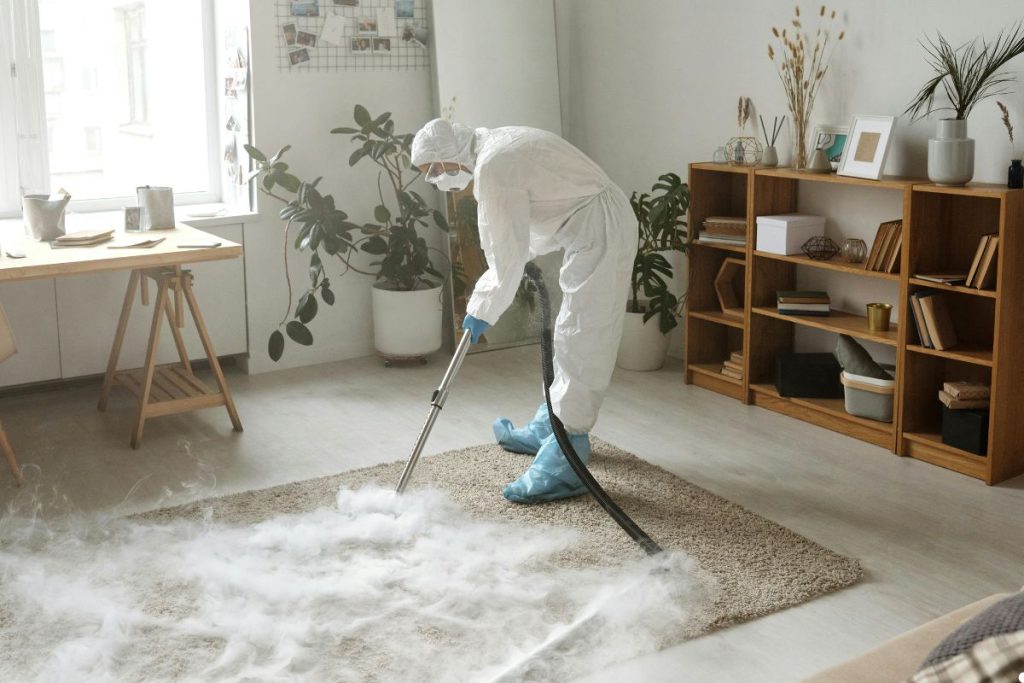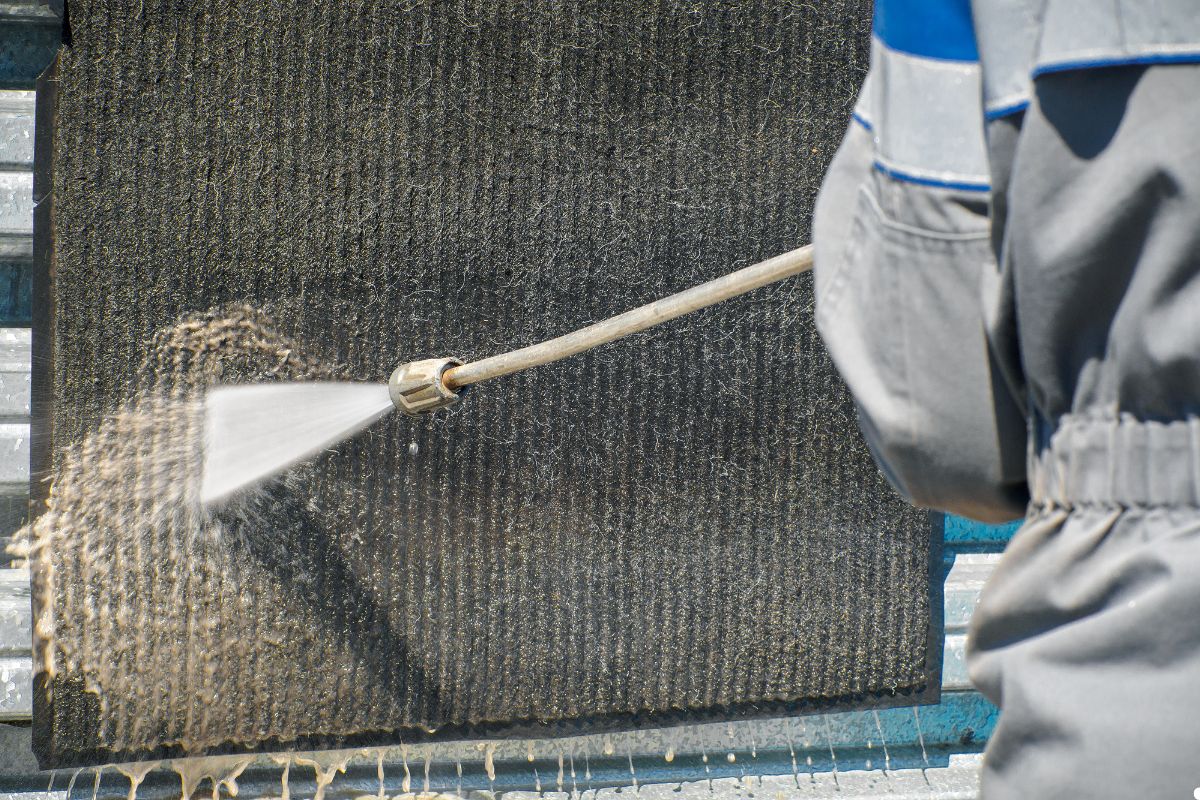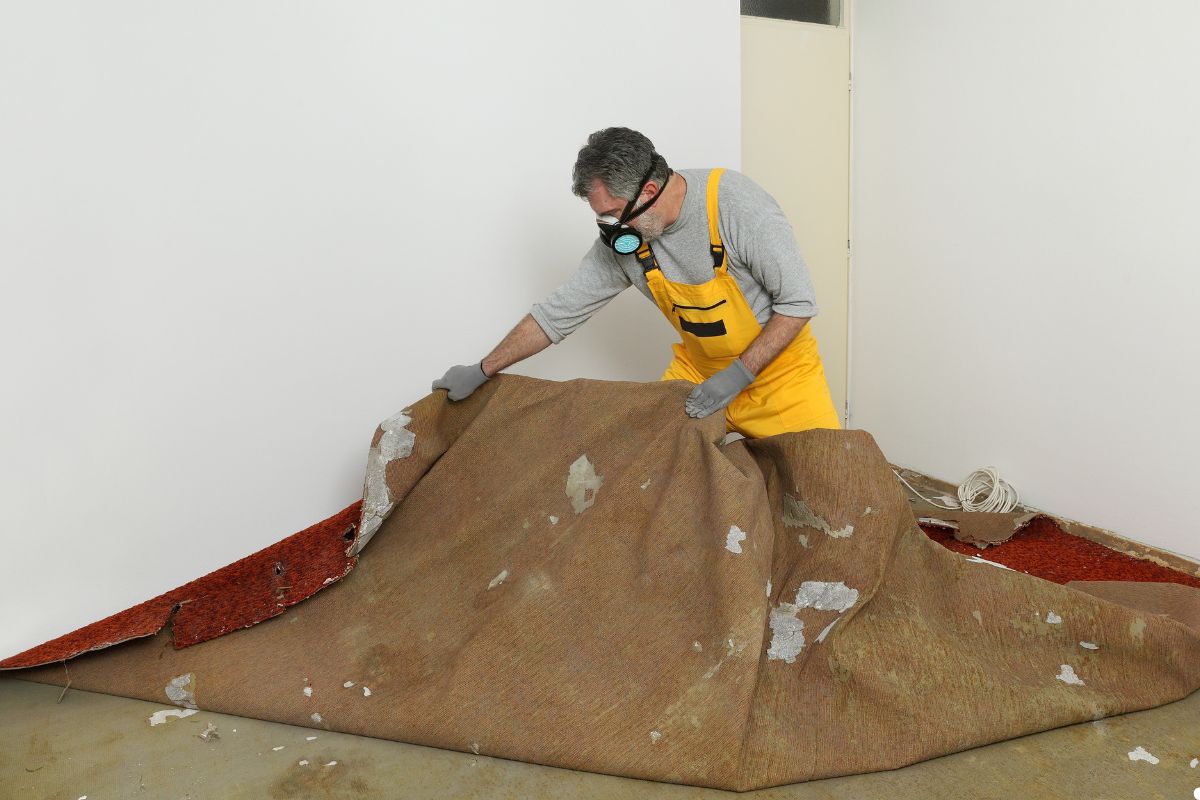
Absolutely, you should wear a mask when removing carpet! Old carpets harbor a cocktail of dust, allergens, mold spores, and other irritants that can be released into the air during removal. Protecting your respiratory system with a mask is a simple yet crucial step to safeguarding your health and preventing potential long-term issues. For professional carpet removal, call us today!
Why Carpet Removal Can Be Hazardous
Removing old carpet isn’t just a matter of pulling it up and tossing it out. It can stir up a hidden world of particles that have accumulated over years of use. These particles can be harmful when inhaled, triggering allergic reactions, respiratory problems, and other health concerns. Taking precautions, like wearing a mask, is essential for protecting your well-being. If you’re replacing your carpet, using carpet cleaning services beforehand can prevent allergens and bacteria from affecting your indoor air quality.

The Hidden Dangers Lurking in Your Carpet
What exactly makes old carpets so risky to remove? Here’s a breakdown of the potential hazards:
Dust and Debris
Carpets act like giant filters, trapping dust, dirt, pet dander, and other airborne particles. Disturbing the carpet releases these accumulated particles into the air, creating a cloud of potentially irritating dust. Choosing the right types of carpet can help reduce allergen accumulation and improve indoor air quality.
Allergens and Irritants
Dust mites, pet allergens, and other common allergens thrive in carpets. Removal activities can send these allergens airborne, triggering allergic reactions such as sneezing, coughing, watery eyes, and skin irritation.
Mold and Mildew
If your carpet has been exposed to moisture – from leaks, spills, or high humidity – mold and mildew can grow within the fibers. Disturbing the carpet during removal can release mold spores into the air, posing a health risk, especially to those with sensitivities.
VOCs (Volatile Organic Compounds)
Older carpets and the adhesives used to install them can emit VOCs, which are chemical gases that can irritate the eyes, nose, and throat.
Why a Mask is Your First Line of Defense
A properly fitted mask acts as a barrier, preventing you from inhaling the harmful particles released during carpet removal. Think of it as your first line of defense against dust, allergens, mold spores, and other irritants.
Types of Masks for Carpet Removal
While a simple dust mask offers some protection, it’s not sufficient for the level of exposure during carpet removal. A respirator mask, specifically an N95 or P100 respirator, provides much better filtration and protection.
Understanding Respirator Ratings (N95, P100)
- N95 Respirator: Filters at least 95% of airborne particles, including dust, allergens, and some mold spores.
- P100 Respirator: Filters at least 99.97% of airborne particles, providing even greater protection.
Proper Mask Fit is Essential
A respirator mask is only effective if it fits properly. Make sure to follow the manufacturer’s instructions for fitting and sealing the mask to your face. A loose-fitting mask will allow particles to bypass the filter.
Who is Most Vulnerable?
While everyone should take precautions during carpet removal, certain individuals are more vulnerable to the harmful effects:
Individuals with Allergies or Asthma
Allergens and irritants released during carpet removal can trigger or worsen allergic reactions and asthma symptoms.
People with Compromised Immune Systems
Individuals with weakened immune systems are more susceptible to infections from mold spores and other microorganisms.
Children and the Elderly
Children and the elderly often have more sensitive respiratory systems, making them more vulnerable to the harmful effects of inhaled particles.

Beyond the Mask: Additional Safety Precautions
Wearing a mask is a critical step, but it’s not the only safety precaution you should take during carpet removal:
Ventilation is Key
Open windows and doors to ensure adequate ventilation in the work area. This helps to remove airborne particles and reduce exposure. To maintain a healthy environment, our services emphasize adequate airflow through open windows and doors.
Protective Clothing (Gloves, Eye Protection)
Wear gloves to protect your hands from irritants and sharp objects. Eye protection, such as goggles or safety glasses, is also important to prevent dust and debris from entering your eyes.
Cleaning Up After Removal
After removing the carpet, thoroughly vacuum the area with a HEPA filter vacuum cleaner to remove any remaining dust and debris. Ensure a spotless, dust-free space with our HEPA filter vacuuming service. Contact us today for a cleaner, healthier home!
Frequently Asked Questions
Is a regular dust mask enough?
No. A regular dust mask provides minimal protection and is not sufficient for the level of exposure during carpet removal. An N95 or P100 respirator mask is recommended.
How often should I change my mask?
Change your mask if it becomes soiled, damaged, or difficult to breathe through.
What if I experience symptoms after carpet removal?
If you experience symptoms such as coughing, sneezing, shortness of breath, or skin irritation after carpet removal, consult a doctor.
How to Dispose of an Old Carpet Safely?
Check with your local waste management authority for guidelines on proper carpet disposal. Consider wrapping the carpet in plastic to minimize dust and debris during transport.
Protecting Your Health During Carpet Removal: A Summary
Removing old carpet can expose you to a variety of health hazards, including dust, allergens, mold spores, and VOCs. Wearing a properly fitted N95 or P100 respirator mask is essential for protecting your respiratory system. In addition, ensure adequate ventilation, wear protective clothing, and thoroughly clean up after removal. By taking these precautions, you can minimize your risk and protect your health during carpet removal. For professional assistance, call us today!
